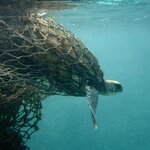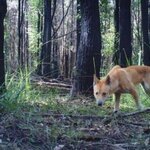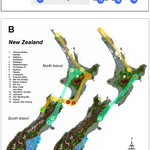Ecology & Zoology

Six new species of Dracula ants from the Malagasy region have been discovered and they represent a completely new twist in the typically rigid caste system of ants, where anatomy is typically destiny.
Mystrium species have unique features such as long, spatulate mandibles that snap together (Gronenberg et al. 1998); wingless queens that in some undetermined species are even smaller than workers (Molet et al. 2007); and large, wingless individuals intermediate between workers and queens, which behave like queens (Molet et al. 2012).
Mystrium poses a fiendish problem Mystrium to…

The University of the Basque Country Cell Biology in Environmental Toxicology group has conducted research using thick-lipped grey mullet and in six zones and report acquisition of feminine features by male fish in all the estuaries, not only in the characteristics of the gonads of the specimens analyzed but also in various molecular markers.
According to Miren P. Cajaraville, director of the research group, the results - Arriluze and Gernika in 2007 and 2008, Santurtzi, Plentzia, Ondarroa, Deba and Pasaia since then -show that "endocrine disruption is a phenomenon that…
The Rhynchohyalus natalensis in a recent paper was caught about 1000 meters under the Tasman Sea and it has two pairs of eyes, allowing it to spot danger from every angle. One pair is upward-facing tubular eyes, to spot danger from above, while another set is on the side of its head, to detect bioluminescence from deep sea creatures.
The second type of eye is typically associated with invertebrates. The authors write that this is only the second instance in a vertebrate, after Dolichopteryx longipes, with both reflective and refractive optics.
I particularly liked the description of…

Seabirds, sea turtles and marine mammals can be unintended victims – by-catch – of global fishing. Accidental entanglement in fishing gear is the single biggest threat to some species in these groups, according to a new analysis co-authored by Stanford biology Professor Larry Crowder that provides a global map of this by-catch.
During the past half-century, fish hauls around the world have increased from about 19 million tons per year to more than 154 million tons per year. By-catch doesn't help anyone but can lead to "major changes in ecosystem function and process," the study's…

An ancient stick insect species,
Cretophasmomima melanogramma from in Inner Mongolia at the Jehol locality, may have mimicked plant leaves for defense as far back as 126 million years ago, during the Cretaceous period, according to a new study.
Many insects have developed defense mechanisms, including the ability to mimic the surrounding environment. Stick and leaf insects mimic plants from their environment, but scientists know little about the original of this interaction due to little or no previous stick insect fossil records showing this adaptation.
The scientists discovered three…

Even after over 1,500 years frozen in Antarctic ice, moss can come back to life and continue to grow.
Writing in Current Biology, the team report that they observed moss regeneration after at least 1,530 years frozen in permafrost. For the first time, this vital part of the ecosystem in both polar regions has been shown to have the ability to survive century to millennial scale ice ages and it is the first study to show such long-term survival in any plant; similar timescales have only been seen before in bacteria. Mosses are known to survive environmental extremes in the short-term…

The agave's claim to fame is as the plant from which the distilled adult beverage Tequila, named after the nearby town that made it famous, is produced.
But that may change. A sweetener created from the agave plant could lower blood glucose levels for the 26 million Americans and others worldwide who have type 2 diabetes and even help the obese lose weight, according to a paper presented at the National Meeting of the American Chemical Society (ACS).
The reason is that agavins, a natural form of sugar found in the agave plant, are non-digestible and can act as a dietary fiber, so…

Poisoning of dingoes - wild dogs - has a deleterious effect on small native mammals such as marsupial mice, bandicoots and native rodents, according to a new paper which found that loss of dingoes after baiting is associated with greater activity by foxes, which prey on small marsupials and native rodents.
As well, the number of kangaroos and wallabies increases when dingoes, the top predators in the Australian bush, disappear. Grazing by these herbivores reduces the density of the vegetation in which the small ground-dwelling mammals live.
"Dingoes should not be poisoned if we want to…

Sardines have been a hot news topic in recent weeks. Environmental groups and others have claimed that the sardine population is collapsing like it did in the mid-1940s.
The environmental group Oceana has been arguing this point loudly in order to shut down the sardine fishery. That’s why they filed suit in federal court, which is now under appeal, challenging the current sardine management.
So what is the truth about the state of sardines? It’s much more complicated than environmentalists would lead you to believe. In fact, it’s inaccurate and disingenuous to compare today's fishery…

Just how many species existed of the extinct New Zealand moa? The status for extinct moa (Aves: Dinornithiformes) from the genus Euryapteryx isn't as clear cut as it might seem.
Dr. Leon Huynen, lead author of a new paper said the challenges of understanding extinct fauna can be formidable and particularly so when it comes to this ancient bird. "Despite more than 100 years of research being devoted to the issue, determining species status is challenging, especially where there is an absence of substantial morphological, physiological, and behavioral data.
"Moa were comprised of a…